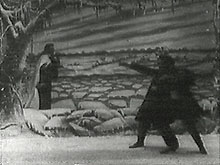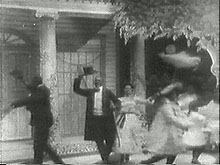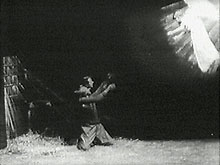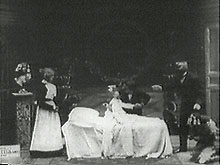
Working for Thomas Edison, Edwin S. Porter was the first American "director," the pioneer who discovered how to use Edison's invention to tell stories and entertain audiences. His Uncle Tom's Cabin (1903) was one of the very earliest "full-length" American movies -- although "full-length" in 1903 meant about 14 minutes. According to A NOTICE in The New York Times, it premiered on August 3rd at Huber's Fourteenth Street Museum; sharing the program with it were several live acts, including a married team of "colored comedians."
Porter shot the film inside the Edison Company's studio in New York, and made sure there was no doubt whose film it was by including a sign displaying the Thomas A. Edison ® in almost every one of the 14 separate scenes. (Edison had reason to be proprietary; within weeks after this film was made, Sigmund Lubin, his Philadelphia competitor released "A DUPE" of it.) The movie's actors, sets, costumes, and much of its stage "business" derive from one of the turn-of-the-century theatrical "Tom Shows." Other than Edison's name, the film contains no credits, and which UTC Company Porter employed has never been learned. But although many changes were required to turn a five act drama into a one-reel silent movie, Porter's film is extremely valuable as a partial record of what thousands of live audiences saw when the "Tommers" came to town.
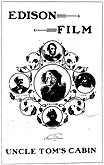
Since most people in the film's original audience would have seen at least one "Tom Show," they already knew not just the larger story (and so could fill in the many gaps created by telling the story of a 500-page novel or a 3-hour play in less than 14 minutes), but the dialogue and "stage business" of the individual scenes. The catalog that the Edison company prepared to help sell the film to exhibitors provides descriptions that help 21st century viewers "see" what is going on in each of the following scenes as those original viewers did, and so we've included the catalogue text alongside each clip. As the catalogue also notes, Uncle Tom's Cabin was the first American film ever to include titles (called "announcements" here) to identify and introduce each new scene.
Like the typical "Tom show," this performance uses white actors in blackface for the major "black" parts, and black performers only as extras. This version also gives a vivid idea of how the "Tom show" version of Stowe's novel depicted slavery; most of the time, even at a slave auction, the slaves can't help dancing. The movie's subtitle is Slavery Days, which suggests its makers and its viewers believed this re-presentation was faithful to historical reality.
The movie was shot in 14 sequences, each with its own stage set and film title. The clips below are identified by the "announcements" used in the film. When a sequence ran to much more than 30 seconds, however, the file size became unwieldy, so we've divided those sequences into two parts as "QuickTime Movies." The "QuickTime Slideshows," however, preserve each sequence as a unit.
